
Finned tubes are utilized in applications requiring the transfer of heat from a hotter liquid to a colder liquid across the tube wall. The efficiency of heat transfer depends on several factors, including the temperature difference between the two liquids, the heat exchange rate between the liquids and the tube wall, and the surface area exposed to each liquid.
Table of Contents
- What is a Finned Tube?
- Types of Finned Tubes
- Why Are Finned Tubes Made of Aluminum?
- Working Principle of Finned Tube Heat Exchangers
- Specifications of Low Fin Tubes
- Applications of Helical Solid Finned Tubes
- Advantages of Using Finned Tube Heat Exchangers
- Key Features of G-Type Finned Tubes
- Quality Assurance for Stainless Steel Finned Tubes
- Size Range of G-Type Fin Tubes
- Classification of Finned Tubes Based on Process and Fin Shape
- Comparison: High Fin Tubes vs. Low Fin Tubes
- Causes of Leaks in Low Fin Tubes
- Factors Affecting Heat Transfer in Low Fin Tubes
What is a Finned Tube?
Finned tubes are elongated tubes with fins on their outer surfaces that serve as heat exchangers. These fins facilitate the transfer of heat between the exterior and interior of the tube, making them essential components in heat exchanger systems. They play a crucial role in transferring heat effectively between thermally efficient fluids.
Explore Different Types of Finned Tubes for Heat Exchangers
The following table provides an overview of the key types of finned tubes used in heat exchangers. This information will help you determine which type best suits your specific needs and applications. Each type is designed to meet particular requirements and functions.
Types of Finned Tubes
| Type of Fin | Image | Tubular Material | Fin Material | Fin Height | Fin Thickness | Tubular Diameter |
|---|---|---|---|---|---|---|
| Plain Finned | 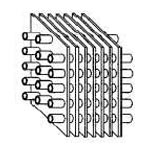 |
Carbon steel, stainless steel, copper, aluminum | Aluminum, copper, stainless steel | 6-25 mm | 0.2-0.6 mm | 12.7 mm (1/2") to 63.5 mm (2.5") |
| L-Finned | 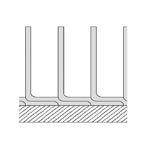 |
Carbon steel, stainless steel, copper | Aluminum, copper, stainless steel | 6-19 mm | 0.3-0.5 mm | 15.9 mm (5/8") to 38.1 mm (1.5") |
| G-Finned | 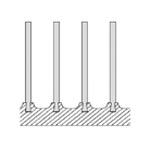 |
Carbon steel, stainless steel, alloy steel | Aluminum, copper | 6-15 mm | 0.3-0.5 mm | 15.9 mm (5/8") to 50.8 mm (2") |
| Extruded Finned | 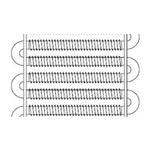 |
Aluminum, copper | Aluminum | 8-16 mm | 0.4-1.2 mm | 12.7 mm (1/2") to 31.8 mm (1.25") |
| U-Tube Finned | 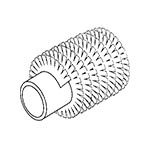 |
Carbon steel, stainless steel, alloy steel | Aluminum, copper, stainless steel | 6-25 mm | 0.3-0.5 mm | 15.9 mm (5/8") to 38.1 mm (1.5") |
| Studded Finned | 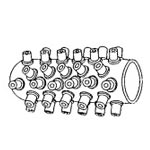 |
Carbon steel, stainless steel, alloy steel | Carbon steel, alloy steel | 10-50 mm | 6-12 mm | 25.4 mm (1") to 114.3 mm (4.5") |
| Helical Finned |  |
Carbon steel, stainless steel, copper, aluminum | Aluminum, copper, stainless steel | 8-16 mm | 0.3-0.5 mm | 12.7 mm (1/2") to 76.2 mm (3") |
Refer to Sizes and Uses of Finned Aluminum Tubing
Finned aluminum tubing is commonly used in applications such as refrigeration systems and air conditioning, as well as in industrial processes involving heating and cooling. Its high heat transfer capacity and durability make it a preferred choice over other types of heat exchangers.
Why Are Finned Tubes Made of Aluminum?
Aluminum finned tubes typically range from 3/8" to 1 1/2".
Aluminum is widely used in the manufacture of finned tubes due to its excellent properties:
- High thermal conductivity
- Lightweight
- Excellent corrosion resistance
- High ductility and malleability
- Cost-effective
Working Principle of Finned Tube Heat Exchangers

Finned tube heat exchangers are primarily used to transfer heat from one fluid to another through the tubes, with fins enhancing the efficiency of heat transfer.
Low Fin Tubes Have Fins Approximately 1/16 Inch in Height
A low fin tube is an individual tube made of a specific material with a small fin approximately 1/16 inch in height. The fin is located within the tube wall boundary. It is commonly used in applications involving liquid-to-liquid or liquid-to-gas purposes, such as in coolers, chillers, and condensers.
Specifications of Low Fin Tubes
| Description | Size Dimension |
|---|---|
| Tubular Outer Diameter | Minimum 12.7mm / Maximum 31.75mm |
| Tubular Thickness (Plain Section) | Minimum 1.245mm / Maximum 3.404mm |
| Fin Pitch | 19 – 26 – 27 – 28 – 30 – 36 fins per inch |
| Fin Height | Maximum 1.40mm |
| Tubular Length | Maximum 25000mm |
Welded Helical Solid Finned Tubes Widely Used in Petrochemical Industry
These tubes offer resistance to corrosion, high-pressure, and extreme temperature conditions. As a result, they are extensively used in the petrochemical industry or in industrial boilers where such conditions are common. They are employed to heat, cool, or enhance heat recovery from industrial exhausts.
Applications of Helical Solid Finned Tubes
- Petrochemical industries
- Natural gas processing
- Blast furnaces and converter systems
- Power generation
- Waste incinerators
- Air conditioning
- Compressor coolers
Advantages of Using Finned Tube Heat Exchangers
- Enhances Heat Transfer Rate
- Improves Heat Transfer Coefficient
- Reduces Equipment Size
- Makes Projects Cost-Efficient
- Increases Outside Surface Area
Key Features of G-Type Finned Tubes
- High Fin Stability
- Superior Heat Transfer Efficiency
- High Operating Temperature Capability
- Rugged Temperature Resistance
- Exceptional Thermal Shock Resistance
Quality Assurance for Stainless Steel Finned Tubes
- Chemical Composition Analysis
- Dimensional Inspection
- Flattening Test
- Non-Destructive Testing
- Hydrostatic Testing
- Mechanical Property Evaluation
- Expansion Test
- Surface Quality Assessment
Size Range of G-Type Fin Tubes
| Base Tube Specifications | Fin Specifications | |||
|---|---|---|---|---|
| Outer Diameter (mm) | Wall Thickness (mm) | Height (mm) | Thickness (mm) | Pitch (mm) |
| 15.88-50.8 | 1.0-3.0 | 6.35-25.4 | 0.4 | 2.1-6.0 |
| Material | Material | Length | ||
| SS, CS, Alloy Steel, Copper | CS, Aluminum, Copper | ≤ 15m | ||
Classification of Finned Tubes Based on Process and Fin Shape
| Tubular Outer Diameter | Fin Thickness | Fin Height | Fins per Pitch |
|---|---|---|---|
| 5/8 | .015 / .016 / .020 | 3/8, 1/2 | 6, 7, 8, 9, 10, 11, 12 |
| 3/4 | 5/8, 1/2 | ||
| 1 | 5/8, 1/2 | ||
| 1 1/4 | 5/8, 1/2 | ||
| 1 1/2 | 5/8, 1/2 |
Finned Tubes Generally Use Air to Cool or Heat Fluids Such as Water
Finned tubes significantly increase the surface area of the tube, providing more effective heat transfer with air. Utilizing air for heating or cooling is advantageous because it is readily available, cost-effective, and eliminates the need for complicated heating equipment or tools, even reducing the requirement for labor-intensive operations.
High Fin Tubes vs. Low Fin Tubes
| Features | High Fin Tubes | Low Fin Tubes |
|---|---|---|
| Fin Density | Higher fin density | Lower fin density |
| Heat Transfer Efficiency | Superior heat transfer efficiency due to higher fin density | Lower heat transfer efficiency compared to high finned tubes |
| Surface Area-to-Volume Ratio | Higher surface area-to-volume ratio due to fin density | Lower surface area-to-volume ratio due to modest fin density |
| Maintenance and Cleaning | Requires more maintenance and cleaning due to closely spaced fins | Less maintenance required due to more spaced-out fins |
| Cost Considerations | More expensive due to complex manufacturing processes and materials | Cost-effective |
Causes of Leaks in Low Fin Tubes
- Scale Buildup: This narrows the inner diameter of the tube, leading to pressure buildup and eventual leakage.
- Thermal Shock: Rapid temperature changes can cause cracks or ruptures in the tube.
- Improper Installation: Proper installation and regular maintenance can help prevent leaks.
- Tubular Corrosion: Corroded tubes are prone to leaks.
Factors Affecting Heat Transfer in Low Fin Tubes
Several factors influence the effectiveness and efficiency of heat transfer in low fin tubes:
- Properties of the fluid
- Arrangement of the fins
- Number of fins
- Dimensions of the fins
- Surface finish
Freezer Working Room,Cryogenic Freezer Working Room,FRP Freezer Working Room
Inamori Technology (Wuxi) Co., Ltd. , https://www.carbonfibrefactory.com